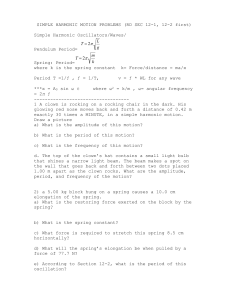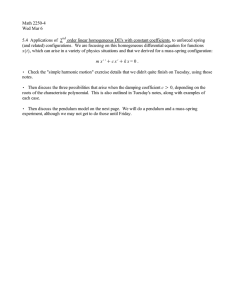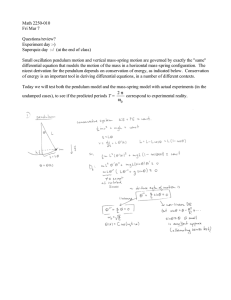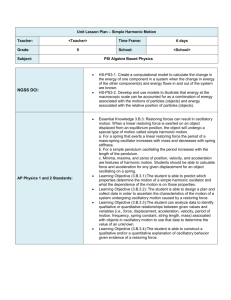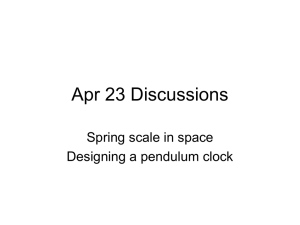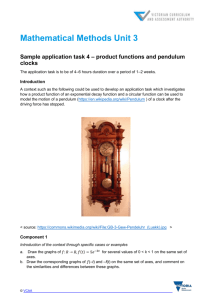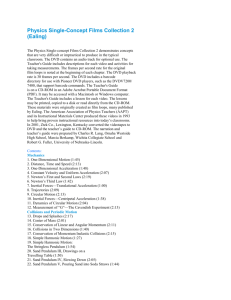Harmonic Motion: Amplitude, Period, Frequency & Examples
advertisement
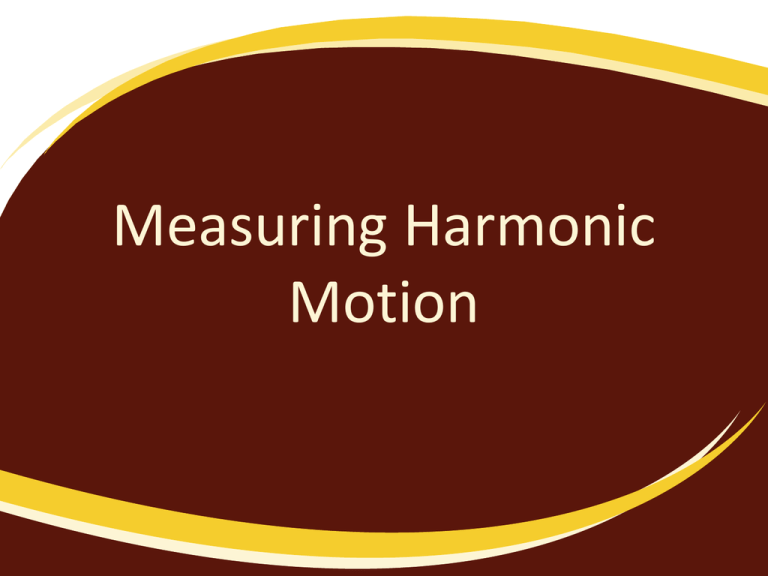
Measuring Harmonic Motion Amplitude • Maximum displacement from the equilibrium position Period • Period is represented by T • T= is the time it takes for a complete cycle of motion measured in seconds • During T , the displacement is zero Frequency • Frequency is represented by f • f= is the number of complete cycles through a unit of time • SI units of s-1 (Hertz) Frequency and Period • Frequency and period are inversely proportional F= 1/T and T= 1/F F is # of cycles/per unit time T is time /cycle Period of a Simple Pendulum • Depends on string length and free fall acceleration • Ex. #1 - 2 pendulums with different masses, have the same period • Ex. #2 - 2 pendulums have different amplitudes, have the same period Period of a Simple Pendulum • T = 2 ∏ √ (L/g) • Period = 2 ∏ X √ (length divided by 9.81) Period of a Simple Pendulum • Why does the length of the string affect the period? • The shorter the pendulum, the smaller the arc to travel through Period of a Simple Pendulum • Why doesn’t the mass and amplitude affect the period? – Heavier mass has a greater restoring force and larger force to achieve the same acceleration – Free fall is the same, regardless of the mass Example 1 You need to know the height of a tower, but darkness obscures the ceiling. You note that a pendulum extending from the ceiling almost touches the floor and that its period is 12 seconds. How tall is the tower? L = 36 m Example 2 If the length of the string in the previous problem was halved, what would the period be? 8.5 seconds Example 3 The cables of a trapeze are approximately 3.5 m long. What is the period of an acrobat swinging on this trapeze? 3.8 seconds Example 4 What is the frequency of an acrobat swinging on the trapeze described in Example 2? 0.26 Hz Example 5 Calculate the period and frequency of a 3.500m long pendulum at the following locations: The North Pole, where g= 9.832 m/s2 3.749 s; 0.2667 Hz Example 6 Calculate the period and frequency of a 3.500m long pendulum at the following locations: The Chicago, where g= 9.803 m/s2 3.754 s; 0.2664 Hz Example 7 Calculate the period and frequency of a 3.500m long pendulum at the following locations: The Jakarta, Indonesia, where g= 9.782 m/s2 3.758 s; 0.2661 Hz Period of a Mass-Spring System • Restoring force is determined by the displacement • Magnitude of the mass, does not affect the restoring force • Therefore, mass increased both force on the bob and the bob’s inertia Period of a Mass-Spring System • Heavy masses have smaller accelerations, than light masses • Heavy masses will take more time to complete one cycle of motion • Heavy masses = greater period Period of a Mass-Spring System • Greater the spring constant = greater force and acceleration • Period will decrease Period of a Mass-Spring System • Greater the spring constant = greater force and acceleration • Period will decrease Period of a Mass-Spring System • T = 2 ∏ √ (m/k) • Period = 2 ∏ √ (mass divided by spring constant) Example 8 The body of a 1250 kg car is supported on a frame by four springs, each of which has a spring constant of 20,000 N/m. Two people riding in the car have combined mass of 153 kg. Find the period of vibration of the car when it is driven over a pothole in the road. T = 0.84s Example 9 What is the frequency of the vibration from Example 8? 1.2 Hz Example 10 If two more people enter the car, the occupants total mass increases to 255 kg. What is the period of vibration of the car now? 0.87 s Example 11 How long will it take the car in Example 10 to complete three vibrations? 2.6 s Example 12 A pendulum swings from maximum displacement on one side of equilibrium to maximum displacement on the opposite side of the equilibrium. If the pendulum swings through a total of 24 °, what is the amplitude of this vibration 12 °


